I know you all are familiar with what is SEO. So, here we will talk about one of the types of SEO which is on-page SEO.
To rank better on search engines, you need to know the SEO techniques especially on-page SEO techniques.
Understanding on-page SEO techniques is crucial to increase your traffic and brand awareness significantly.
Website’s that provide well-optimized SEO friendly content, rank better on search engines and you can provide well-optimized content by following these on-page SEO techniques mentioned below.
In this article you’ll learn:
- How to optimize your content
- How to optimize meta titles and descriptions
- How to use focus keyword for better ranking
- And many other on-page SEO techniques
But, before knowing the on-page SEO tactics, let’s first talk about, what is on-page SEO?
Table of Contents
What Is On-Page SEO?
On-page SEO is the practice of optimizing web page content for search engines and users. On-page SEO is a technique that helps search engines bots to understand, what your web page is all about.
By optimizing features like title tags, meta description, keywords, internal links, you could get better ranking on search engines like Google and Bing.
To get higher rankings on search engines, you have to focus on two main factors:
- On-page optimization
- Off-page optimization
These two are different parts of SEO optimization. On-page SEO refers to the factors you can control on your own website. While, off-page SEO is the action taken outside your website, such as backlinks from another site.
Today’s article will focus on on-page SEO techniques, so read the full article carefully if you want to see your website on the first page of search engines.
Why On-Page SEO Is Important?
As you know, to know to rank on higher position of search engines, on-page SEO is very important.
Many SEO experts says this term that you should write “SEO optimized articles” because it is necessary.
Have you ever think, why your website is not ranking on Google and other search engines.
Well, there are likely a lot of reasons, but if you are not focusing on on-page SEO, then that’s probably the biggest reason.
But, that doesn’t mean that Google only considers on-page SEO optimization to rank your website, there are also many other factors like backlinks, social media signals, CTR etc.
So, focus on all such factors.
Did you know?
You can rank any website using this very popular formula, CCSB formula.
- C – Content
- C – CTR (Click Through Rate)
- S – Social Media Signal
- B – Backlinks
Write high-quality content on your site, so that, visitors keep coming to your site regularly. Write eye-catchy and attractive titles to increase the CTR of your website.
Share your content on different social media platforms and the most important thing create backlinks for your site.
11 On-Page SEO Techniques You Should Know In 2021
Now, you know the theory of on-page SEO and the importance of on-page SEO. So, let’s move on to the practical part.
Not only 11, there are many more on-page SEO techniques available but these are most important you can apply to your website to quickly boost your SEO.
Here is a summary of all on-page SEO techniques:
- Use Focus Keyword In The First 100 Words
- Boost Your Page Speed
- Keyword Density
- Optimize Meta Title
- URL Optimization
- Publish High-Quality Content
- Use Table Of Content
- Use Images With Alt Text
- Internal Linking
- External Linking
- Use LSI Keywords
1. Use Focus Keyword In The First 100 Words
This is an oldest on-page SEO tactic that still makes a difference.
Focus keyword gives a signal to search engine bots about, which keyword you are targeting in your post and on which specific keyword you want to rank on Google.
To give this signal to search engine bots, all you need to do is use your focus keyword in the first 100-150 words of your article.
As you can see in this same article, I have used the focus keyword “on-page SEO techniques” in the beginning.
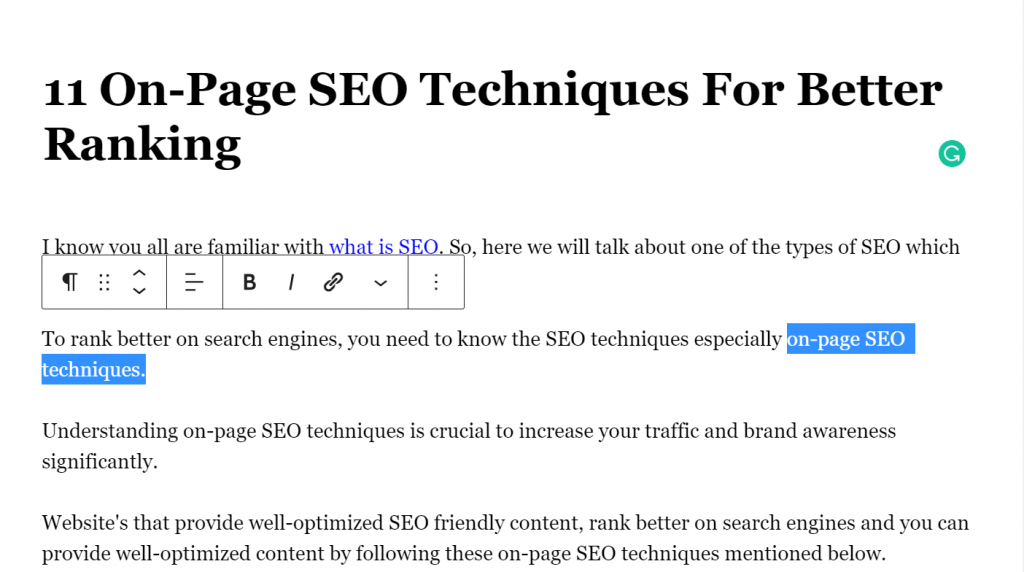
Why is it important?
Because Google puts more weights on terms that show up early in the page.
When you use focus keyword at the beginning of the article, Google recognizes the keyword quickly and by observing the quality of your content, provides a position to your site for the specific keyword.
Using the focus keyword in the first 100-150 words is one of the little things that help Google understand what your page is all about.
2. Boost Your Page Speed
If you are not focusing on your website speed then it can affect your rankings very badly.
Google is announcing core web vitals will become ranking signals in May 2021.
One of the main factors of this update is speed. If your website speed is low, you can lose your rankings.
To check and optimize the performance of your web pages, you can use GTmetrix because they have also updated themselves according to the core web vital update.
Now they show results as shown in the image below:
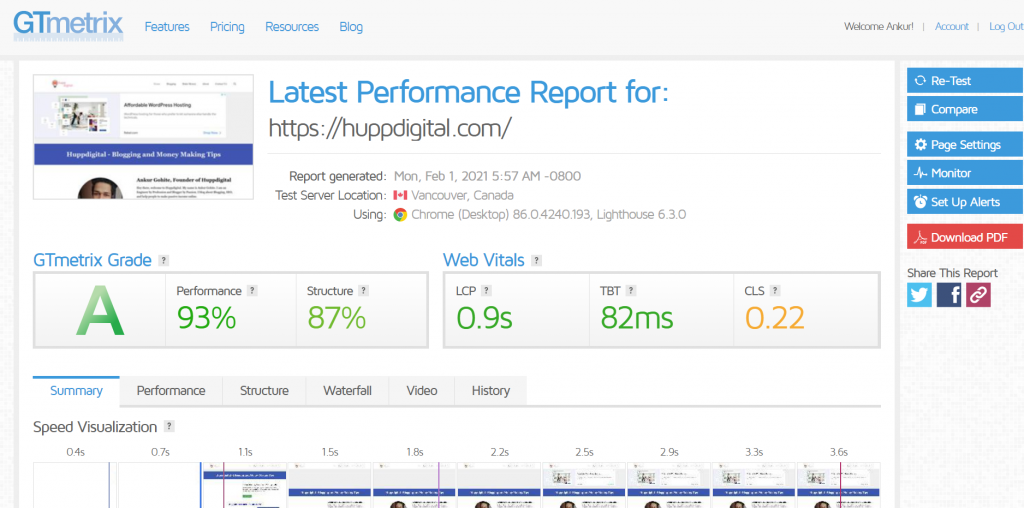
When you use GTmetrix to check the speed and performance of your webpages, it displays the result in three different formats, LCP, TBT, and CLS.
- Latent Contentful Paint: The time it takes for a page’s main content to load. For a good user experience, aim for an LCP of 1.2s or less.
- Total Blocking Time: It tells you how much time is blocked by scripts during your page loading process. For a good user experience, aim for a TBT of 150 ms or less.
- Cumulative Layout Shift: The amount of unexpected layout shift of page content. An ideal measurement is less than 0.1.
Optimize all these to obtain high speed web pages.
Also, you can improve your site’s loading speed by moving to a faster host. So, for better performance always use a faster hosting.
3. Keyword Density
Keyword density refers to the number of times a keyword appear on a given webpage.
By using keyword in your content, you can tell Google crawler about the specific keyword you are targeting in the content.
If you have written a long article and have used focus keyword only once then how Google will determine, which keyword you are targeting.
On the other hand, if you are using the focus keyword 10 times in the content then Google can easily determine the focus keyword.
This is not about the bad practice of keyword stuffing, it’s simply mentioning your focus keyword a few times.
There is no ideal keyword density percentage. You won’t find any guidelines from Google that tell you exactly how many keywords a blog post should contain.
The most important thing is to keep the copy natural and use the focus keyword only few times.
4. Optimize Meta Title
Meta title is one of the most important on-page SEO factors. The meta title is the part of your content that shows up in the search results.
People see the title in SERP’s (search engine result pages), and then they click on your website URL and read the content.
When you write attractive and optimized titles, the more people click on it. And in general, more number of clicks means higher the ranking.
Also, when search engine read your pages they check the meta title and description of the page. They do so because they need to understand what the page is all about and based on other factors such as, backlinks, authority and competition, they provide a position to your page.
You should write unique titles for every pages to provide a clarity to search engines.
If you don’t know how to write attractive titles for your blog post, spend some time and learn to write attractive titles for your blog posts.
However, the basic title optimization tips are:
Use the keyword at the beginning of page title: When you use this technique, it helps Google to understood from the beginning, what keyword you are targeting in your blog post.
But, use this technique if it’s possible, don’t do the keyword stuffing. If it’s not possible to add your targeted keyword at the beginning of page title then at least try to add in the title, wherever possible.
Use Power Words: Power words are tried-and-true words that copyrighters use to attract more clicks. Use words like amazing, attractive, better, crucial, etc.
Use Numbers in your page titles: We know that numbers grab the attention of people mind, that’s why heading that contains numbers are 36% more likely to generate clicks.
Use sentiment in the title: This is a proven way to get more clicks on your website in SERP’s. When you use strong emotional sentiment (positive or negative), it helps to increase the number of clicks.
So, always use these on-page SEO techniques to make your page titles more attractive and clickable.
5. URL Optimization
Optimization of URL is an important on-page SEO metric. To make your URL’s good and SEO friendly, use hyphens ‘-‘ to separate different parts.
Never use special characters, symbols, brackets, commas, etc in the URL.
Example of good URL’s:
- https://huppdigital.com/blogging/
- https://huppdigital.com/9-best-google-adsense-approval-trick-2021/
- https://huppdigital.com/how-to-make-money-as-a-teenager-without-a-job/
You can change the permalink structure in WordPress setting:
- Open Your WordPress dashboard
- Click on Setting
- Now, click on Permalinks
- Edit settings
You will get the different structure of permalinks like the plane, day and name, numeric, post name and many more.
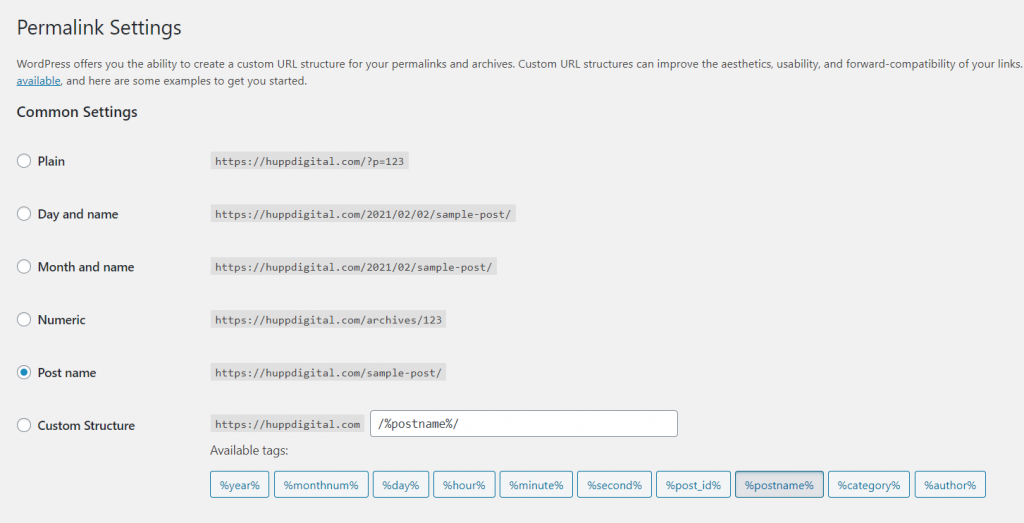
In my recommendation, choose the post name structure for your website or create a custom structure according to your need.
Best Practices For Optimizing Your URL Structure:
- Use simple permalink structure (domain.com/post name)
- Prefer dashes over underscores
- Use keyword in your URL
- Never change URL’s after publishing
6. Publish High-Quality Content
Content is the most important part of your website. People visit your website to read the content, and if the quality of your content is not good, they will not revisit your website.
If you have read the content of top bloggers like Neil Patel and Harsh Agrawal. You have definitely noticed one thing that they provide quality content on their site.
Google also rank only those sites that provide quality and long-in-depth content that’s why long articles rank better than short articles.
So, what type of content is considered as high-quality content. High-quality content has the following characteristics:
Original Content: Always provide original content on your site. Don’t just copy and paste the content from other sites and publish it on your website, this bad practice can affect the overall performance of your website.
Long Articles: Long articles rank better on search engines because they contain more information. On this site, I try to write at least 2500 words articles.
Here is a question for better understanding.
How many times have you seen the short articles on the first page of Google?
Write well-researched content: Write content that provides some value to readers. For writing such type of content, you have done proper research on your niche.
Besides the above characteristics, you have to make sure that your content satisfies the search intent. Before publishing any content, observe the top 10 sites that are ranking for your targeted keyword.
Check their content length, look for the LSI keywords they are targeting and the design of their webpage.
By observing all these things, prepare a checklist for your content and then start writing the content.
For more on creating high quality content, check out:
7. Use Table Of Content
As I have mentioned above, it has become important to write a detailed article. But, with the detailed article, a new problem arrives i.e. navigation.
When you write long articles, readers find it difficult to navigate the full article. So, use a table of content to break down the long content into the short formats.
Not only the table of content help break down content into smaller, digestible chunks. It also helps in improving the ranking of your webpage.
To create table of content, you can use WordPress plugins like:
These plugins will automatically insert a table of content in your blog posts and readers will be able to navigate through your content, easily.
You can configure the setting according to your website requirements. As you can see in the image below, you can configure the position, header label, toggle view, counter, and many more.
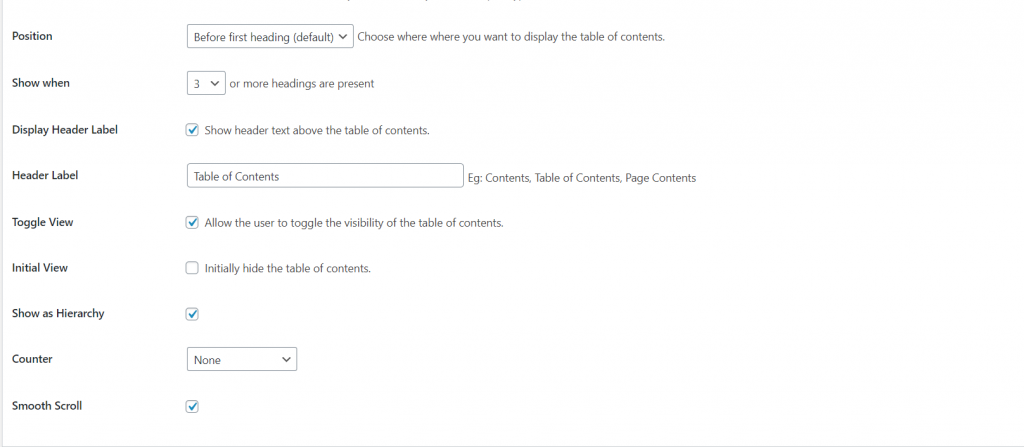
So, if you’re not using a table of content then go and install the table of content plugin because it can result in better ranking.
8. Use Images With Alt Text
Well optimized images helps in driving a lot of traffic from image searches.
If your images are ranking on Google then it can also increase the ranking of your web pages. As people click on the images then land on your site, it increases the traffic as well as CTR and it’s a good ranking signal.
But, how to optimize an image for better ranking?
You can optimize your images by using targeted image titles and alt text.
Before uploading an image, give a meaningful name to image and then add an “alt text”.
Also, use your focus keyword as alt text in images because it makes your images targeted and focused and they start to rank for the focus keyword.
Another advantage of using images is they create engagement by providing practical knowledge to the readers. They like to read your whole content, it reduces the bounce rate of your website, thus increases the overall ranking.
But, there is a disadvantage of using images.
Large images can slow down your website and a slow loading site can decrease your website ranking. So, don’t use large images or compress the images before uploading them to your site.
Many times we use a lot of images in the content and compressing all those images can take a lot of time and I know you don’t have so much time.
But, don’t worry, there is an alternative for compressing images i.e. Shortpixel. This is a tool that helps you to compress your images.
Simply, install it in WordPress and this tool will automatically compress and optimize all of your images.
9. Use LSI Keywords
LSI (Latent Semantic Indexing) keywords are the terms that are related to the main keyword you are targeting.
By using LSI keywords in your posts, you can rank for more than one keyword for the same post.
You can use too many LSI keywords in your posts or pages to boost the relevancy and ranking of your website.
The best way to find LSI keywords is Google’s suggestion:

As you can see in the image, when I have searched for on-page, Google also suggests some other keywords like on-page SEO techniques and on-page SEO tactics.
You can use these keywords in your article to rank it for more than one keyword.
Another way to find LSI keywords are “search-related” terms, you can find this at the end of Google SERP’s.
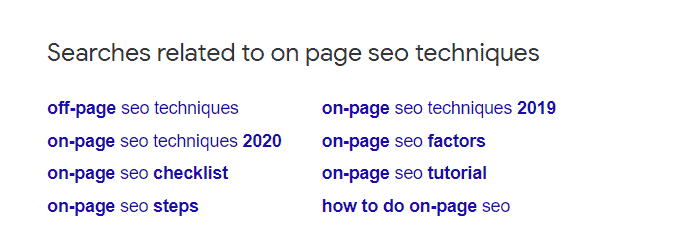
Or you can simply use the LSI graph tool to find all the LSI keywords related to your targeted or focus keyword.
10. Internal Linking
Link from one blog post to another within the same domain is called internal links. Internal linking helps search engine crawl the website pages effectively.
Internal linking is the best thing you can do to increase the user engagement on your site and it also helps to rank the other pages of your site.
If your any keyword or post is ranking on Google, you can interlink other posts with it to boost their rankings.
This process is known as passing link juice to your own web pages.
If your website’s main source of earning is Adsense then internal linking can increase the revenue of your site because reader use to visit other pages of your site and the impression and chances of clicks increase a lot.
While interlinking, try to use focus keyword as anchor text because it will help Google to crawl the page and focus keyword at the same time.
But, don’t do interlinking a lot. Interlink only those posts that are relevant to original post.
11. External Linking
External links are links that point to some other domain from your site.
Not only internal linking but external linking is also one of the most important on-page SEO techniques.
When you link out to related domains, it helps to increase the trust and quality of your site which plays an important role in your blog’s SEO.
But, only link out to those blogs that are trustworthy and related to your blog niche, linking out to spammy blogs can affect the SEO performance of your site.
When you link out to other blogs, it gives the search engine a clear idea about your blog because of relevant links and it can help you to rank for relevant keywords.
There is a misconception of external linking, many people think that adding external links to their content will take away their visitors but this is not right thinking.
External links give a signal to search engines that you are providing more relevant information to users by linking out to other blogs.
On-Page SEO Checklist For 2021
Use this on-page SEO checklist to check whether you are using on-page SEO techniques correctly or not.
Keyword Placement Tips
- Add focus keyword in the title.
- Add focus keyword to your SEO meta description.
- Use the focus keyword in the URL.
- Use the focus keyword in the first 100 words.
- Use focus keyword in subheadings.
- Focus keyword in the image alt text.
- Try to use the focus keyword near the beginning of SEO title.
- Use LSI keywords to make your content more relevant.
- Use LSI keyword in subheadings.
On-PAGE SEO Factors For Better Ranking
- Boost your page speed.
- Optimize images before uploading.
- Optimize URL.
- Write long articles for better information.
- Use the Table of Content.
- Use FAQ schema.
- Permalink length should be at most 75 characters long.
- The meta description should be less than 160 characters.
- Internal links.
- External links to relevant sites.
Wrapping Up On On-Page SEO Techniques
Now, you know how you can rank your website using the on-page Techniques.
I hope these 11 techniques will help make your on-page SEO much better and your chances of ranking on a search engine will increase.
So follow these tips and also share your optimizing tips with us in the comments in the comment below.
Share this with your friends to help them optimizing their blog posts.
If You Have Any Questions or Problems, Feel Free to Ask, And I Will Respond As Quickly As Possible.
Pin It
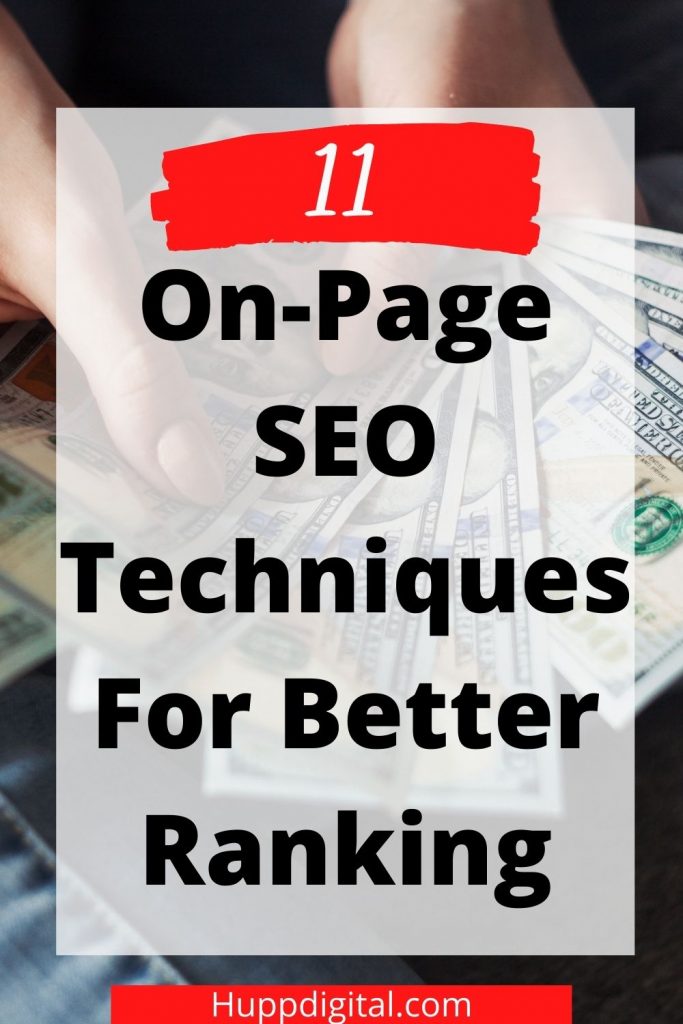
FAQ’s
Q1. Can Good Content Improve My SEO Score?
Publishing high-quality content can definitely increase the SEO score of your site. So, always focus on providing high-quality content.
Q2. What is On-Page SEO Score?
The on-page score measures the overall SEO performance of your site. The higher the number of scores, the higher the chances of rankings.
Q3. What Are The 5 Most On-Page SEO Optimization Factors?
1. Page Speed
2. Optimized Content
3. Optimized meta title and description
4. Focus keyword placement
5. Internal and External links
Hey Friend!
I am Ankur Gohite, the founder of Huppdigital. A blog that provides authentic information regarding blogging, SEO, affiliate marketing, and how to make money online.


1 thought on “11 On-Page SEO Techniques For Better Ranking [2021]”